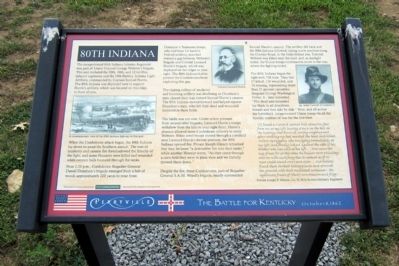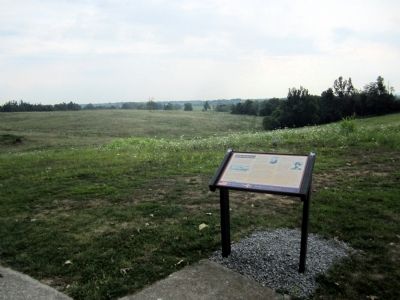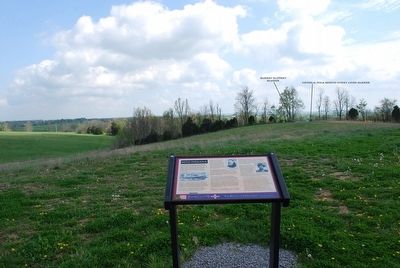Perryville in Boyle County, Kentucky — The American South (East South Central)
80th Indiana
Perryville • The Battle For Kentucky
— October 8, 1862 —
When the Confederate attack began, the 80th Indiana lay down to await the Southern assault. The roar of musketry and cannon fire foreshadowed the ferocity of the fight, and some Hoosiers were killed and wounded when cannon balls bounced through the ranks.
Near 2:20 p.m., Confederate Brigadier General Daniel Donelson’s brigade emerged from a belt of woods approximately 200 yards to your front.
Donelson’s Tennessee troops, who had been hit hard by Federal artillery, marched toward a gap between Webster’s brigade and Colonel Leonard Harris’s brigade, which was deployed on the ridges to your right. The 80th Indiana had to prevent the Confederates from exploiting this gap.
The ripping volleys of musketry and booming artillery was deafening as Donelson’s men clawed their way toward Samuel Harris’s cannon. The 80th Indiana moved forward and helped repulse Donelson’s men, who left their dead and wounded scattered in these fields.
The battle was not over. Under severe pressure from several rebel brigades, Leonard Harris’s troops withdrew from the hills to your right-front. Harris’s absence allowed more Confederate infantry to strike Webster. When rebel troops moved through a cornfield near Leonard Harris’s former position, the 80th Indiana opened fire. Private Joseph Glezen remarked that they let loose “a destructive fire into their ranks,” while another Hoosier wrote, “As they came through a corn field they were in plain view and we literally mowed them down.”
Despite the fire, these Confederates, part of Brigadier General S.A.M. Wood’s brigade, nearly surrounded Samuel Harris’s cannon. The artillery fell back and the 80th Indiana followed, taking a new position along the Dixville Road, in the fields behind you. Colonel Webster was killed near the road, and, as daylight faded, the Union troops continued to move to the rear, where the fighting ended.
The 80th Indiana began the fight with 738 men. They lost 27 killed, 116 wounded, and 14 missing, representing more than 21 percent casualties. Sergeant George Washington Potter, Jr., later lamented, “The dead and wounded lay thick in all directions, friends and foes side by side.” Here, and all across the battlefield, inexperienced Union troops faced the horrific realities of war for the first time.
“[I] found a 6 pound cannon ball about two feet from me at my left, having struck on the hill on the battery, and bounced coming angling and after striking my hat, mashed the head and killed Milton Spraggins, who was lying immediately at my left, and finally lodged against the side of his brother who was still at his left…now came the tug of war for at this time the bullets were whistling over me with such fury that it seemed as if no man could stand erect and alive…our bullets found them in their hiding places and strewed the ground with their mutilated carcasses—the legitimate fruit of [their] own treason and folly.”
—Private, Jospeh P. Glizen, Co. H, 80th Indiana regiment
Erected by Kentucky Historical Society and the Indianapolis Civil War Round Table.
Topics. This historical marker is listed in this topic list: War, US Civil.
Location. 37° 40.24′ N, 84° 58.772′ W. Marker is in Perryville, Kentucky, in Boyle County. Marker is on Whites Road west of Battlefield Road (Kentucky Route 1920), on the right when traveling north. Located in Perryville Battlefield State Historic Site. Touch for map. Marker is at or near this postal address: 1825 Battlefield Road, Perryville KY 40468, United States of America. Touch for directions.
Other nearby markers. At least 8 other markers are within walking distance of this marker. General Polk Behind Enemy Lines (within shouting distance of
this marker); Harris' Battery (within shouting distance of this marker); George P. Webster's Brigade (about 400 feet away, measured in a direct line); Illinois Soldiers at Perryville (about 800 feet away); The John C. Russell House (approx. 0.2 miles away); Russell House (approx. 0.2 miles away); Dixville Crossroads (approx. 0.2 miles away); The Slaughter Pen (approx. 0.2 miles away). Touch for a list and map of all markers in Perryville.
More about this marker. On the left is a drawing of “A contemporary view of the 80th Indiana fighting on this spot”
On top is a portrait of “Colonel Leonard Harris”
On the upper right is a portrait of “Sgt. James Cantwell of Company G”
Also see . . .
1. Perryville. American Battlefields Trust (Submitted on August 25, 2011, by Bernard Fisher of Richmond, Virginia.)
2. Photos of the clearing of modern structures to restore view. (Submitted on October 14, 2020, by Mark Hilton of Montgomery, Alabama.)
Credits. This page was last revised on February 25, 2021. It was originally submitted on August 25, 2011, by Bernard Fisher of Richmond, Virginia. This page has been viewed 1,257 times since then and 40 times this year. Last updated on November 3, 2019, by Bob R Bogle of Tucson, Arizona. Photos: 1, 2. submitted on August 25, 2011, by Bernard Fisher of Richmond, Virginia. 3. submitted on September 15, 2015, by Brandon Fletcher of Chattanooga, Tennessee. • Devry Becker Jones was the editor who published this page.


